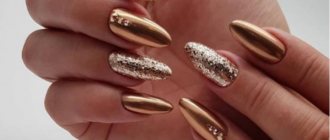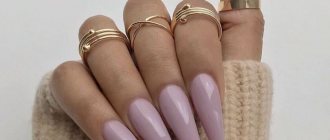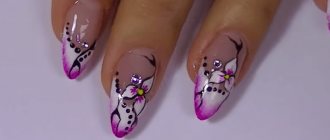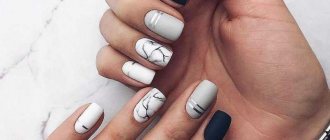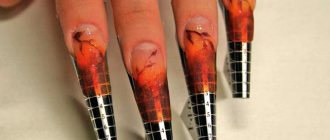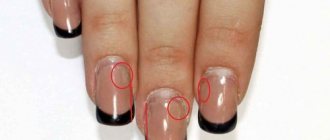Rating: 4/5 (1)
Self-care is about constantly working on your body. It’s a big mistake to think that you don’t need to do anything else besides a manicure. Your legs also attract attention, especially in summer . To care for your toenails, you don’t have to go to a beauty salon; all procedures can be performed at home. Pedicure involves extension of toenails using the same means that are needed for manicure of hands. The only difference is in the design of the work environment.
Benefits of toenail extensions
Extending toenails will help hide defects such as:
- cracks;
- uneven nail surface;
- plate delamination;
- ingrown nails: with the help of extensions, the growth trajectory of the nail plate changes, which prevents ingrown nails;
- unsightly shape of nails, formed due to frequent wearing of uncomfortable shoes;
Due to uncomfortable shoes or poor quality socks, the nail plate can become deformed and take on an unaesthetic appearance. This procedure will also be an excellent solution for girls who cannot grow their nails due to their fragility. The material used for extensions is harder than the natural nail plate, it will prevent chips and cracks.
The artificial material is not sensitive to the negative effects of varnish, so the design can be changed frequently. Toenails do not grow quickly, so the material, when worn carefully, can last for more than a month, providing long-term well-groomed and aesthetically pleasing feet. Due to the smoothness of the coating, it is easier to decorate and treat extended nails than natural ones.
Extension of toenails, photo example. Finished nails are well varnished.
It is recommended to carry out corrections once every 4 weeks and not to remove the material yourself, as the first thin layer of the natural plate may be removed along with the synthetic coating.
Useful tips from experts to make the gel last longer
Sometimes the question arises why the gel does not stick to the nails. The reasons may be different:
- insufficiently prepared nails;
- thin nail plate (it is almost impossible to remove the fatty film from it);
- careless attitude (impacts, prolonged contact with water, etc.);
- taking certain medications (antibiotics are eliminated from the body through the skin, nails and hair);
- build-up on “critical days”;
- increased sweating of hands;
- pregnancy;
- frequent contact with chemicals;
- the body rejects artificial material;
- pathologies of the digestive tract, endocrine or cardiovascular systems.
Colored gels must be applied in a thin layer to prevent the appearance of unevenness and gaps. They become more durable after repeated polymerization.
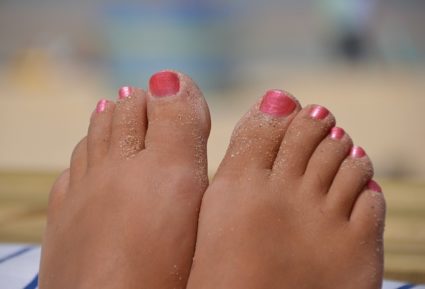
You can avoid premature destruction of the coating with the help of expert recommendations:
- Do not use hand cream on the day of extensions.
- You should not file the plates yourself or expose them to mechanical damage (knock on a hard surface).
- Do housework with rubber gloves.
- After extension, avoid contact of the plates with water for 2-3 hours.
- Choose a comfortable length and shape (especially for the first time).
- If damaged, contact a specialist; do not try to fix it yourself.
If you first familiarize yourself with possible contraindications before applying the coating and follow the recommendations for nail care in the future, questions about why the gel comes off will not arise.
https://ladysdream.ru/naraschivanie-nogtey-poligelem.htmlhttps://ameno.ru/uxod-za-licom-i-telom/narashhivanie-nogtej-poligelem.htmlhttps://nogotochie.ru/pedikyur/narashhivanie- gelem-nogtej-na-nogax.html
Contraindications
Extending toenails has contraindications. It is necessary to refuse the extension procedure if there is a fungus, because due to the lack of access to the natural plate, it will be impossible to treat the disease; the fungus will begin to progress.
Small cuts or wounds are also a contraindication, so it is worth treating the cuticle 2 days before or after extensions. During chemotherapy or antibiotic treatment, you should also avoid artificial material on your nails, as the body produces acetone, which causes its rejection.
Extension can correct small cracks, but it cannot be carried out if a crack has formed in the nail matrix: this will provoke the development of infection in the growth area of the nail plate. Allergic reactions should be considered a special category of contraindications. Girls who are initially prone to allergies are at risk.
If after extensions your toes become red, itchy or swollen, the material must be removed immediately. It is recommended to test for an allergic reaction before starting the procedure: to do this, you need to apply a drop of the material on your wrist without polymerization.
Allergies occur due to substances contained in the gel consistency for correction and extension, agents that remove artificial material, and glue for fixing tips. Methacrylate is a synthetic component of materials for correction and design; it most often causes allergies during extensions.

Sensitivity to methacrylate and other allergens increases during pregnancy, as well as with diseases of the kidneys, thyroid gland, and liver. The reaction may appear throughout the body immediately or after several hours. People with sensitive skin should pay attention to the lamp for polymerizing the gel; allergies may also occur due to radiation.
Kinds
Polygel nail extension step by step requires choosing a quality material. There are many options available on the market today.
Among all the diversity, two main types of material can be distinguished:
- acrylics;

- products with a gel/jelly structure.
The first option (acrylatics) is most similar in properties to acrylic mass. To obtain it, powder and monomer are mixed. In such compositions you can even notice minimal particles of acrylic. The material has a paste-like structure - thick and dense. To distribute it over the nails, the mass must be pressed against the plate with some force.
Acrylic technology is most widespread in America and Europe. Local craftsmen prefer to work with such compositions. Domestic craftsmen often order them directly from the USA or Germany. The second option with the texture of a thick gel (“soufflé”, “jelly”) looks different. You won’t find noticeable acrylic particles in the mass.
The main advantage of such products is the ability of most of them to independently level the nail plates.
Irregularities in the material can be easily eliminated during modeling, and it does not spread around the edges. Such compositions are most often produced in Korea and China. They are especially loved by manicurists from Russia. Polygels from different manufacturers are also available for sale. Which one to choose, each master decides independently, taking into account his own preferences in working with nails.
Don't miss the most popular article in the section: Laser hair removal on the face and body - how it is done, effectiveness, before and after photos, contraindications.
Required materials and tools
The tools and materials needed to extend the nail plate at home are presented in the table. They are no different from the means that masters use. You should choose high-quality tools and materials, because the health and aesthetics of your nails depends on quality.
| Materials | Tools |
| Transparent base gel | Ultraviolet lamp 24 – 36 W |
| Gel for modeling and fixing | Files: rectangular and oval 100 – 180 grit |
| Primer | Pusher |
| Degreasing solution | Brushes with hard bristles, straight and tapered |
| Manicure glue | Four-way buff |
The gel hardens due to polymerization occurring under the influence of ultraviolet light, so a lamp is a necessary item. The polymerization time is related to the type of equipment, consistency and thickness of the coating. It is better to choose a lamp with a large working surface from a trusted manufacturer.

For independent use, you can purchase an inexpensive device with fluorescent lighting, for professional services - with an LED, since it is more durable with frequent use. After the gel has hardened, a cleanser is applied to remove the sticky part of the coating.
To prepare natural nails for the extension procedure, it is recommended to use ceramic or glass files.
It is better to process only artificial plates with iron tools. For natural nails, files with a hardness of 240 grit are used, for artificial nails - from 80 to 240 grit. When shaping the nail plate at the free edge, it is recommended to use oval files, at the cuticle - a boomerang shape, when polishing - rectangular files.
The buff is designed to work with both natural and artificial plates. All sides of this tool must have different hardness. The buff needs to be processed frequently, so polyethylene foam is suitable as a material. The tool is designed to smooth out unevenness of the nail plate, eliminate peeling and polish nails.
A pusher removes dead cuticle cells before applying gel polish. One end of the tool is shaped like a spatula, the other is shaped like an arrow. Stainless steel is suitable as a material. It is worth choosing a pusher with a grooved handle, as it will prevent your fingers from sliding over the tool, which means minor cuts.
To form a synthetic nail plate, you need straight and tapered brushes with hard bristles. The material must be synthetic. Before use, you need to check whether the bristles are firmly seated in the brush. It is recommended to remove dust that appears during processing of the coating with a synthetic manicure brush.

The gel can combine from one to three phases. Single-phase gel is used as a modeling agent, base, and finish. The two-phase system is designed for modeling and protection, used after the base. The three-phase product provides a base for a modeling coating and a finish. Using a camouflage finish in pastel shades will visually elongate the nail bed.
Nails that are properly applied look natural and do not require design; this material also hardens quickly in a lamp, which is why its popularity is growing. When giving length to nails, the material on which the gel will be applied is used. Forms made of hard paper or plastic are designed for this.
The paper form is attached under the natural nail plate, and the gel is laid out in a dense layer on top. The gel is laid out on plastic forms, then the material is applied to the natural nail. Manicure glue is necessary for nail extensions with tips. The tips are made of soft plastic, so they are easy to shape.
Before applying the base layer, a degreasing agent is applied to each nail: this ensures a tight fit of the artificial material to the natural plate and prevents peeling of the extended nails. Acid-free products delicately treat fragile nails, while acidic products open the nail scales.
Master class on application
Polygel nail extensions step by step is a process that may not be immediately clear to beginners. A detailed master class will help you understand all the intricacies. To work with polygel you should always stock up on a special degreaser. Sometimes regular alcohol is used instead. This is necessary so that the material does not stick to the brush and does not complicate the process of laying out the composition.
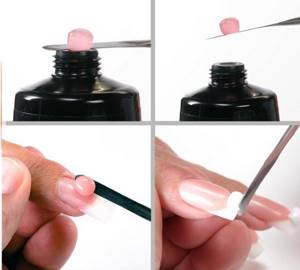
Today there are many known ways to use the tool under discussion. Most often it is taken for extensions (both on the upper and lower forms). But you can also use it to correct nail plates, strengthen them, and make prosthetics.
This is acceptable even if the extension was initially carried out using gel or acrylic. The materials interact well with each other, so there is no need to be afraid of detachments. Of course, if the nails have been properly prepared beforehand.
To properly extend your nails with polygel, you need:
- Perform a manicure according to the standard scheme. We accept both classic and hardware. The main thing is to carefully remove the pterygium at the final stage.
- Treat the entire surface of the nail plate with a degreaser, acid or acid-free primer. The choice of product for this stage will depend primarily on the degree of moisture in the nails.
- Immediately apply a thin layer of base. In this case, it is used not so much to level the nail plate, but as an adhesive layer. The base helps to securely fix the polygel on the nails. That is why it is applied with fine rubbing movements. It is not necessary to even out your nails and achieve perfect smoothness. It's okay if the plate turns out to be slightly ribbed.
- The base must be thoroughly dried. Only after this lay out the acrylic. To do this correctly, you should moisten the brush with clinser or alcohol, but not too much. Other special liquids are also suitable for this stage.
- Blot the moistened brush with a lint-free cloth. It should not be wet, but slightly damp.
- Using a spatula, squeeze out a small amount of polygel from the tube. Place it on the nail plate and spread. This should be done with the same movements as when using regular acrylic - gently patting the surface. The material easily stretches to the desired area, for example, to the side rollers or to the cuticle. Therefore, you should immediately place the drop in the very center of the nail, and only then level it up, down and to the sides.
- Pull the remaining composition that is no longer needed for work to the tip. Remove them with a brush. You can knead and stretch the material for a very long time until it is fixed in the lamp. Until this point, it will remain soft and can be adjusted endlessly. It is best to carry out extensions one plate at a time, so as not to accidentally touch the neighboring ones and spoil them.

Secure the result with a lamp. If a high power hybrid device is used, 30 seconds will be sufficient. All that remains is to remove the sticky layer and file the extended nails. Processing polygel plates is very easy. The material is soft and plastic. You can quickly achieve the correct beautiful shape of the nail and the ideal smoothness of its surface. Experienced professionals advise treating the nail in a lamp for 10 seconds when applying extensions. in a loose form, then clamp it with tweezers and continue the process with the entire structure. This will allow you to achieve the correct shape of the plates and a perfectly even arch.
Polygel is used not only for nail extensions, but also to strengthen them. This process can also be carried out independently, following step-by-step instructions. To strengthen with polygel, first prepare your nails as standard. And then pull the brushes from the cuticle area to the free edge of the plate. This will allow you to achieve optimal nail thickness.
If the tip of the plate is cracked, it can be restored with polygel without cutting it low and without waiting for it to grow back. The discussed composition can also be used for nail prosthetics in case of fungal infection and in cases where the plate peels off and lags behind the skin. There is no need to take forms.
The material can be applied directly to the skin after preparation - filing, treatment with a degreasing composition, removal of the exfoliated part of the nail (if necessary). The skin must be treated with antiseptics, which destroy microbes accumulated under the nails. Next, the material is laid out and heated in a lamp.
Features of gel polish and polygel coating
Gel polish combines the properties of a corrective gel and decorative varnish. The coating is durable, hard, wearable, the product corrects imperfections, allows you to add length, and does not fade over time. You can remove gel polish using liquid or sawdust; an ultraviolet lamp is required to harden the product.
When applied to the nail plate, the product spreads in a thin layer, so it is sometimes difficult to control the contour of application. Despite the small thickness of the coating, it is difficult to hide regrowth areas. Gel polish allows air to pass through, which allows the nail cells under the coating to breathe.
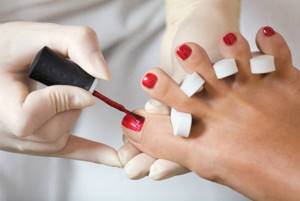
Due to the need for polymerization in a lamp, the risk of developing a fungal infection during extensions becomes minimal, but burning and discomfort may be felt during irradiation. When processing or cutting off this coating with a manicure machine, light dust is generated, which can cause discomfort for the client and the master, so it is better to use a hood when working with this material.
Gel polish is a soft material that makes it easy to make corrections after extensions.
Toenail extensions can also be done with polygel. The consistency of this material resembles plasticine, so it is easy to control the border and shape of application: there is no risk of the material getting on the skin. You can extend nails using this material on both hands and feet. The material does not fade and retains color for the entire period of wear.
Polygel allows you to smooth out the application border; to do this, just stretch the material with a thin transparent layer using a brush. A special lamp is also required for hardening, but during polymerization there are no uncomfortable sensations. The polygel does not harden in air, which allows you to work with the mold for a long time.
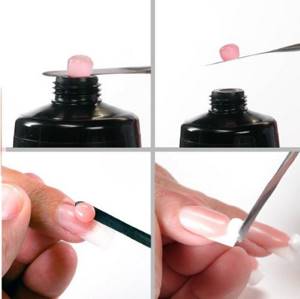
When working with this material, a hood is no longer a necessary tool: when adjusting or removing, a small amount of heavy dust is formed, which is easily removed with a brush.
Polygel allows you to give your nails any shape, since the material is very soft and pliable, any mistake can be easily corrected with a file. This product can only be removed using a manicure machine. A significant advantage is hypoallergenic and odorless.
Step-by-step instructions for extending toenails at home
Before any nail treatment procedure, it is necessary to disinfect the tools: for this you can boil them or treat them with alcohol.
Technology:
- Next, start processing the nail plate. The cuticle must be trimmed, the nail disinfected and degreased. If there are any unevenness, the nail is polished with a buff; in case of chips, it is necessary to remove those parts of the nail plate that have moved away from the skin. If cuts appear on the skin during the treatment, extensions are done only after 2-3 days.
- It is necessary to coat your nails with a primer; it will eliminate the possibility of peeling off the gel or polygel.

- Attach the paper form under the nail. Carefully spread the material onto the plastic mold with a brush.
- The material is laid out on the form. When applying gel polish, precision and quick shaping of the material are required. When working with polygel, the brush with which the material is laid out must be constantly moistened with a degreaser so that the product does not stick to the pile. If the work is done with plastic forms, the material is laid out on a pattern and applied to the nail.
- Place your nails in a lamp to cure the coating. Average hardening time is 2 minutes.
- Carefully remove the forms from the artificial layer: to do this, you need to carefully pull them out.
- The shape and length of the artificial nail is adjusted with files and a buff. Sanding and leveling the surface are required.
- Apply color, create a design, dry finished nails in a lamp.
- Cover with finishing gel to prevent color fading. The finish is applied even if the previous step is missing.
If the coating is damaged, it is important to remove or repair it in time to prevent infection from getting inside. If the design on extended nails is done with a simple varnish, you cannot use liquids with acetone to remove or adjust the coating.
In order to preserve the color of your nail extensions, before applying regular polish, you need to apply a layer of clear polish or gel polish. It is better to remove the coating using a manicure machine, otherwise you can damage the natural nail.
Advice from experienced manicurists
A novice nail extension artist has plenty of opportunities to learn independently using video tutorials or articles on the Internet. It’s better to take real master classes from professionals. They can share their secrets and valuable information. Here are some of the tips:
- To create a three-dimensional design, polygel can be mixed with gel polish.
- To avoid detachment, when applying the material must be carefully pressed against the cuticle.
- The impermeable film created by gels, varnishes, and acrylics serves as a breeding ground for bacteria and fungi. Therefore, disinfection is necessary when using decorative coatings.
- You need to file your nails after they are completely dry. A wet nail plate is very vulnerable to mechanical stress and may begin to peel off.
- Nails need to be given periodic rest to recover, and not even use nail polish.
All stages of the process, from nail preparation to extension and design, are similar to techniques for working with gels and gel polishes. If you have the skill of building extensions with these materials, mastering the use of acrygel will not be difficult.
Fashionable ideas for toenail extensions
Fashion design ideas appear every season, but they are not suitable for every girl. The design should be selected according to the shape and desired length of the nails.
Toenail Shapes:
- Square.

- Soft square.
- Rocker.
- Circle or oval.
- Trapezoid.
The length of the toenails should be comfortable, not causing discomfort or squeezing when wearing shoes. It is recommended to do French nails for any length of nails in square, rocker and trapezoid shapes. The main trends of this year are minimalism and monochrome.
A matte pedicure to match your suit and accessories will look very advantageous. You should not use too active decor in your image: elegant accents are preferable this season. For any shape of nails, a design made in gold or silver metallic is suitable; you can also try combining these colors in one design.
A pedicure in bed colors with a slight emphasis on the big toe is a stylish solution, but it is more suitable for people with a narrow plate, since a light tone can visually expand the nails. If you want to achieve the opposite effect, you should use a dark coating or a combination of a dark color at the edges and a light tone in the middle.
The amber and gradient trend is perfect for any nail shape, especially circle and trapezoid. You can also add light sparkles in the form of flakes at the base of the nail plate to this design. A gradient of glitter or iridescent flakes is especially popular.
Today, geometric solutions in pedicure are popular: these can be broken lines, clear figures, intertwined stripes, but you should choose only the thumb for such an accent. The most popular solutions today are white and red. This trend will help correct the circle, rocker and trapezoid shapes.
Foil of any color will help you create a geometric pattern: small figures made of this material on your nails look modern.
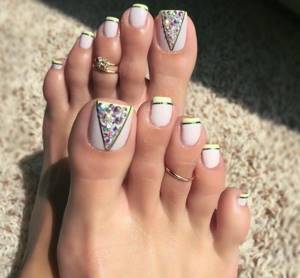
Trendy colors for this season: silver and gold, deep shades of red in a matte finish, white geometry, pastel colors in a matte finish. In bright pedicures, there is a tendency towards abstractionism, for example, chaotic multi-colored spots on a dark background.
When to make a correction
The coating must be corrected in case of damage: cracks, chips. This will prevent infection from entering and developing. In case of pain, allergic reactions, itching or any discomfort, the extended nails must be removed. Reasons for correction also include fading, clouding or discoloration of the coating.
Optimal correction time without the above reasons: gel polish 3-4 weeks, polygel – a month. Nail extensions are a procedure that makes your look well-groomed and full. In the summer, beautiful toenails perfectly complement open shoes, and with careful wear, timely correction and high-quality work by the master, a pedicure can last the entire season.
Author: 00Lena
Article design: Oleg Lozinsky
How much does a procedure cost in a salon?
The cost of services from manicure specialists starts from 1,500 rubles. The price depends on the professionalism of the master and the time it takes to complete the work. The price also includes the price of quality materials. The price formation is influenced by the modeling method. The more complex it is, the higher the cost. In salons with a high level of service, the price of services is traditionally higher.
The gel nail extension procedure is valued for its safety and instant results. If you do it yourself, you should use step-by-step instructions with photos to make the process easier.
Article design: Mila Friedan
